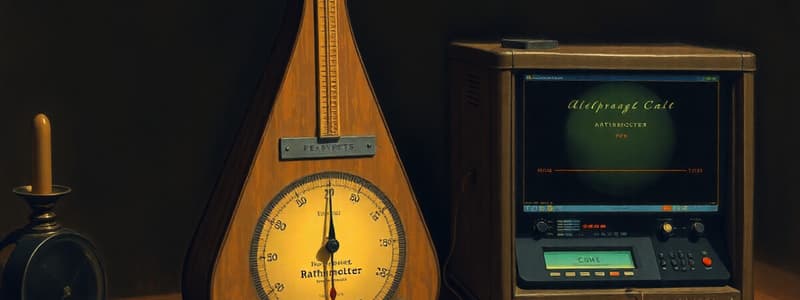Podcast
Questions and Answers
Which of the following machines was invented in 1820 and is known as the first reliable calculating machine?
Which of the following machines was invented in 1820 and is known as the first reliable calculating machine?
- EDVAC
- Stepped Reckoner
- EDSAC
- Arithmometer (correct)
The first generation of computers primarily used transistors and integrated circuits.
The first generation of computers primarily used transistors and integrated circuits.
False (B)
What does EDSAC stand for?
What does EDSAC stand for?
Electronic Delay Storage Automatic Calculator
The major hardware feature of the third generation of computers was the use of __________.
The major hardware feature of the third generation of computers was the use of __________.
Match the following components with their characteristics:
Match the following components with their characteristics:
What was the first commercial computer developed by John Eckert and John Mauchly?
What was the first commercial computer developed by John Eckert and John Mauchly?
The second generation of computers utilized vacuum tubes as their primary component.
The second generation of computers utilized vacuum tubes as their primary component.
What major advancement characterizes the fifth generation of computers?
What major advancement characterizes the fifth generation of computers?
The second generation of computers could process a minimum of ______ instructions per second.
The second generation of computers could process a minimum of ______ instructions per second.
Match the following early computing devices with their significance:
Match the following early computing devices with their significance:
Flashcards are hidden until you start studying
Study Notes
Early Mechanical Calculators
- Arithmometer (1820): Invented by Thomas de Colmar, regarded as the first reliable mechanical calculator that became commercially successful.
- Stepped Reckoner (1672): Developed by Gottfried Wilhelm Leibniz, capable of automatic addition, subtraction, multiplication, and division.
Development of Electronic Computers
- EDVAC: Stands for Electronic Delay Storage Automatic Calculator, notable for the ability to store programs internally, unlike earlier models.
- Electronic Devices: Consist of circuit boards, transistors, silicon chips, and electrical switches, forming the backbone of modern computing technology.
Generations of Computers
-
First Generation (1951-1958): Featured mainframe computers utilizing vacuum tubes and magnetic drums, processing around 1,000 instructions per second. Notable example: UNIVAC, the first commercial business computer.
-
Second Generation (1959-1963): Introduced transistors and magnetic cores, increasing processing speed to approximately 1,000,000 instructions per second. Example: Tradic.
-
Third Generation (1964-1970): Minicomputers emerged with integrated circuits capable of processing 10,000,000 instructions per second. IBM System 360 was a significant general-purpose machine.
-
Fourth Generation (1971-Present): Marked by large-scale integrated circuits, processing speeds exceeding 100,000,000 instructions per second, leading to the rise of GUIs, mice, and handheld devices.
-
Fifth Generation (Present-Future): Focused on Artificial Intelligence (AI), utilizing parallel processing and superconductors for advancements like voice recognition and self-organization.
Notable Early Computers
- ABC (Atanasoff-Berry Computer): Created by John Atanasoff, the first special digital computer designed to solve simultaneous equations.
- Babbage’s Difference and Analytical Engines: Charles Babbage designed these engines for automatic computation of mathematical problems, with significant influence on later computing.
- ENIAC (Electronic Numerical Integrator and Computer): Developed by John Mauchly and J. Presper Eckert, it was the first fully electronic general-purpose digital computer.
Manual-Mechanical Devices
- Oughtred’s Slide Rule: A mechanical analog device featuring movable bars and scales for approximating mathematical calculations.
- Pascaline Calculator (1642): Created by Blaise Pascal, this was the first mechanical calculating device capable of addition and subtraction using cogged wheels.
Studying That Suits You
Use AI to generate personalized quizzes and flashcards to suit your learning preferences.
